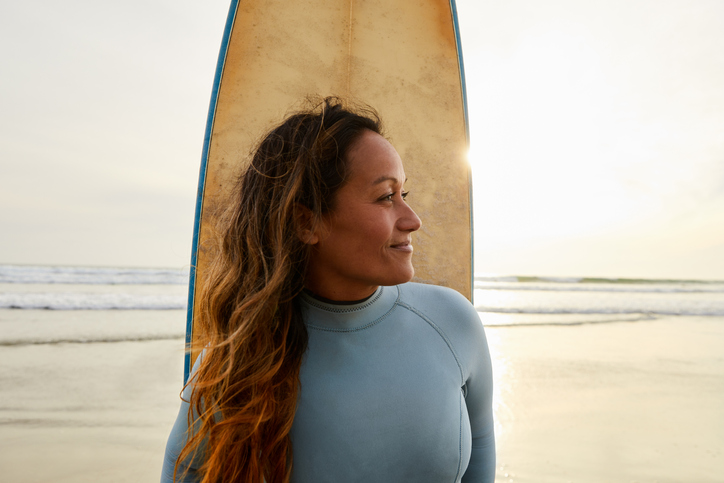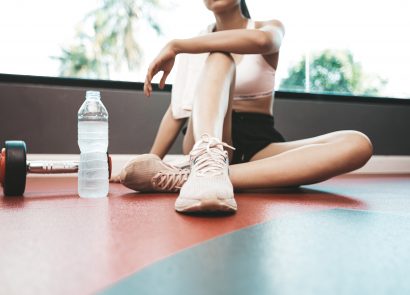Plenty of us have dipped our toe into water sports before: testing our balance on a paddleboard, catching waves while surfing or spent summers as kids splashing around on foam body boards. But as Jamie Johnstone, owner of Dick Pearce bellyboards (and keen bellyboarder) tells us, the original wooden bellyboards – first seen in our seas 100 years ago – are having a moment right now.
“Historically, bellyboarding is the oldest form of waveriding in the UK. It pre-dates surfing and body boarding and has been happening in Cornwall for over 100 years. Bellyboarding was really popular until the 1970s and 80s when cheaper plastic boards were imported from Southeast Asia arrived, then the wooden bellyboard dropped out of fashion for about three decades.”
Now, as wooden bellyboards are beginning to be spotted on UK beaches again, its appeal increases. But how easy – or tricky – is the pastime to pick up? The good news is even a total beginner can give it a go. “Bellyboarding is something almost anyone can take up. If someone has ever caught waves on a body board or surfboard, they should be able to catch waves on their first session,” Jamie explains. “The attraction is that it’s simple fun and maximum enjoyment for everyone.”
What’s all the fuss about?
The benefits of cold-water exercise are well-known: the rush of endorphins as you feel exhilarated and energised from the temperature shock; the boost to your circulation that leaves you with a healthy glow afterwards. Spending time swimming or exercising in cold water is thought to reduce stress and deliver better quality sleep too, as well as being thought to improve energy and immunity levels. When it comes to its feel-good features, bellyboarding offer us plenty: charging in and out of the shallows with a wooden board will give you a decent workout as you’ll be using muscles in your arms and legs, giving yourself an upper body workout, and engaging your core as you try to stay on the board.
Eco credentials
The Keep Britain Tidy Ocean Recovery Project estimates that there are over 16,000 polystyrene boards left on our beaches each year which harm the environment as bits of foam and polystyrene end up in the sea. Jamie believes our appetite for all things sustainable is partly responsible for the resurgence of bellyboarding. By using a bellyboard made of plywood rather than a foam body board, you have a watercraft which will last for decades, rather than a fortnight before it ends up in landfill. “People want things that are genuinely sustainable, not just greenwashed,” he says. “Our boards are made in the UK and sustainably from European timbers. If you look after your bellyboard it should genuinely last a lifetime.”
The Surf Wood for Good initiative came about in an effort to eradicate foam body boards dumped on British coastlines. Twenty-five sites around the UK are offering free hire of wooden bellyboards to allow beach goers to try out bellyboarding for free, while avoiding the problem of cheap, polystyrene boards littering the shore. You can find more details on Facebook Surf Wood for Good or Instagram @surfwoodforgood. Eco aspects aside, seasoned surf folk swear by bellyboarding for a more authentic experience on the waves. “Because of the simplicity of it, as the board is a thin piece of wood, you feel very connected to the water. A foam body board makes you float on top of the water but a wooden bellyboard encourages you to improve your timing,” Jamie adds.
Safe at sea
As with any activity done in the sea, being aware of the risks involved is vital. Andy Bramwell, RNLI community manager (rnli.org) has some tips for bellyboarding safely. Before you head to the beach check the local forecast for wind, tide and swell and check your equipment for damage. “We advise bellyboarders to visit a lifeguarded beach in between the red and yellow flags,” says Andy. “Stay in shallow water and catch waves by launching off your feet. Don’t go on the water in conditions above your capability and if you see anyone in trouble on the coast, call 999 or 112 and ask for the coastguard.”
Beginner steps to bellyboarding
• Go to a lifeguarded beach, stand in waist deep water.
• Push the tail of the board into your hips, while holding the board as close to the nose as possible. You may have to stick your bum out!
• Next, select your wave. It’s important to choose a powerful looking wave that will propel you forward. Look for a wave that has recently broken and has power left in it. Don’t worry if you’re a beginner – wave selection needs to be learnt over time and this comes with experience.
• Hold the nose of the board with your arms outstretched. Your belly and chest should be on the lower half of the board.
• About a second before the wave hits you need to jump forward. If timed correctly, the wave will push you along and you’ll be bellyboarding! But be aware that if you jump too early, you’ll sink and the wave will pass over you; too late and you will miss the wave. This can take a few attempts if you’ve never tried it before.
Timing and wave selection will take a bit of practice until it feels natural then, if you feel confident in the shallows, and fancy more of a challenge you can move the difficulty up a notch. “You can take it up a level and catch bigger waves,” says Jamie. Put on flippers and head out into deeper water, for example. That opens up the options because you’re out in the surf, not in waistdeep water.” Ready to make waves? We’ll be right behind you.



















